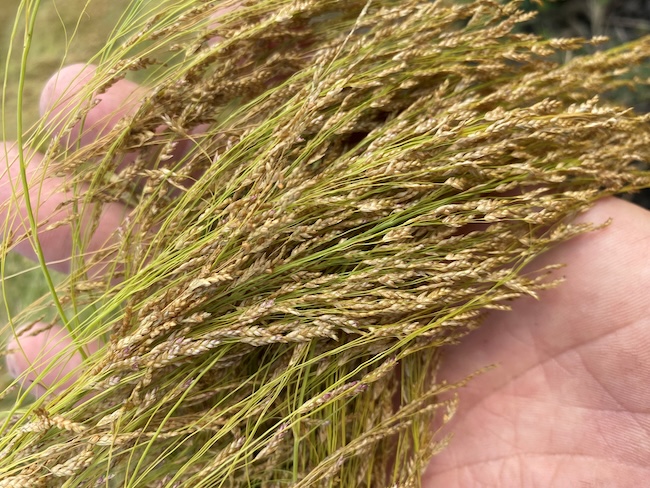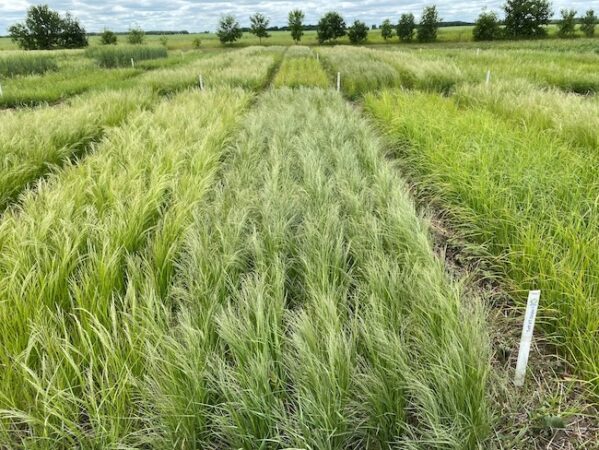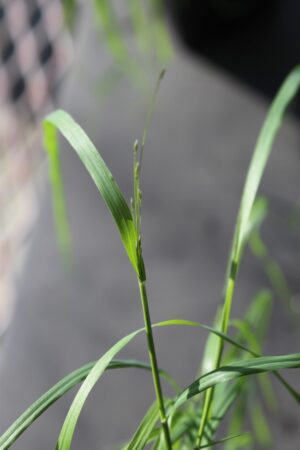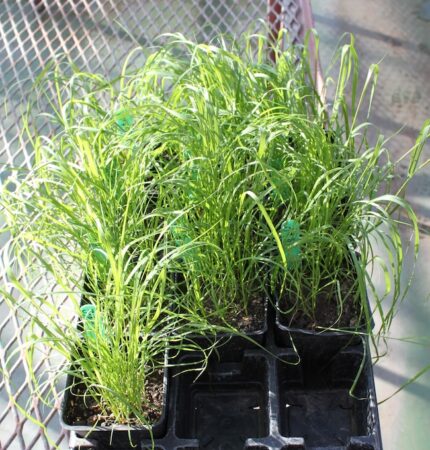
Features
Cereals
Forages
Just the Good News
Growing teff on the Prairies
Teff could be an option as both a cereal and a high protein forage crop.
September 12, 2025
By Adeline Panamaroff
 A close-up of teff grain.
Photos courtesy of James Frey.
A close-up of teff grain.
Photos courtesy of James Frey.
Teff, a cereal grain originating from northeast Africa, has many desirable qualities: high protein content, great carbon fixing in soil, the ability to withstand dryer conditions and the ability to self-pollinate. It also performs well in soils with low fertility. Beginning in 2020 and 2022, multiple research projects are trying to determine the feasibility of growing teff on the Canadian Prairies.
Used as a flour in Ethiopia and Eritrea since 4000 BCE, teff has a growing habit similar to millet with slender stocks and a smaller seed head. In the United States, it’s been a regular component in cover crops, and the hay is commonly grown for the equestrian market in the U.S. – and to a small extent in Canada. However, James Frey, applied research specialist at Parkland Crop Diversification Foundation (PCDF) near Roblin, Man. was first introduced to teff as part of a forage mix.
Crop diversification testing in Manitoba
Starting research on teff in 2020, focusing on its value as a forage crop, Frey accidentally discovered that the harvested plants had developed grain. “It was getting towards the end of September and I rubbed it out in my hands and realized, oh, wow, there’s actually grain in here,” Frey says.
He thought the seed might have been too immature to be viable, but his team combined the crop, just to be thorough. In 2022, they began tests to determine its value as a cereal crop. “We jumped in initially just thinking this would be a good forage option and assumed that it was too much of a long season crop to grow for grain,” Frey says. Now working with 13 different varieties, obtained from a variety of sources including the Saskatoon Research and Development Centre, PCDF is continuing its testing to look at seed yield.
Cultivation challenges
Frey has discovered that seeding teff can be a challenge since it needs to be seeded or broadcast no deeper than a quarter inch to germinate quickly, at the rate of five pounds of seed per acre. “Farmers would be familiar with how to get a small amount of seed onto their fields,” says Frey, “but it’s just important that it is at the right depth.”
Harvest also presents some challenges. While teff has similarities to millet, its seed size is much smaller. “It’s very, very easy to lose seed out the back of the combine,” says Frey. Appropriate combine settings are comparable to settings for Timothy seed, which has a similar size and density. One pro to harvesting teff is that it’s not prone to shattering.
The small size of the grain could be an issue for weed management, too. With similar sized seeds of common weeds like redroot pigweed, mixing could be an issue. “Effective weed management will play a pivotal role in determining the successful cultivation of teff in Alberta,” says Shabeg Briar, research scientist at the Olds College Centre for Innovation (OCCI).
The herbicides that are available are limited to broadleaf weeds, but can take similar treatments to oats, adds Frey.
Alberta testing at Olds College of Agriculture and Technology
Bira Biro Import & Export Enterprise Ltd., based in Edmonton, has been collaborating with Olds College of Agriculture & Technology since 2022 to conduct its own research project on the feasibility of growing teff on the Canadian Prairies. Led by Briar and funded through the National Research Council of Canada Industrial Research Assistance Program (NRC IRAP), Prairies National Research Council Canada and the Government of Canada, this project is in its third year of growing teff in small trial plots, testing growth of the grain and analysing its value as forage.
Briar first conducted a potted greenhouse study with three unregistered teff cultivars, provided by Bira Biro in 2022. “Building on the outcomes of [this] preliminary research […], the subsequent exploratory field study in 2023 aimed at the evaluation of two of the most promising cultivars,” Briar says. The trial plots were arranged in randomized complete block designs, in four recreated sets, to see if the results could constantly be replicated.
During the 2024 growing season, Bira Biro supplied four more teff cultivars, with another being provided by Union Forage, to do larger trials to measure grain yields and forage yield and quality. The results of that season’s study concluded that teff was a viable grain for Central Alberta. “This is an imperative attribute to facilitate commercial-scale production in Alberta, hopefully in the near future,” Briar says.
For forage, teff looked to be a great producer, doing well in the dry conditions that could be persistent in the region. The lab results came back showing that teff has adequate levels of calcium, potassium and magnesium, supporting skeletal health, metabolism and overall livestock health, Briar concluded.
In his discussions with them, Frey has seen interest in teff production from local farmers in Manitoba. His contacts have tried growing the grain on approximately 20 to 100 acres. The key to gaining interest is to let the producers know that teff is a niche crop – and will remain niche for many years to come. This means that the market requires direct contact between the producer and the seller.
Market opportunities for teff
The market shows promise in two areas. There continues to be a growing population of new Canadians from northern Africa who want to continue to consume teff as either a whole grain or as flour here in Canada. While teff is currently being imported from African markets, local production of teff would find a foothold within this demographic. There is also opportunity to export teff internationally, especially to the United States, Europe and Africa. As a gluten-free grain, teff could be an option for specialty food markets, where consumers of gluten-free options would benefit from another choice on grocery shelves.
While there’s still plenty to learn about the growth habit of the plant, teff could be a promising alternative as both a cereal and a high protein forage crop for producers. Given its ability to grow in hot weather and withstand dry conditions, it’s another option in the face of ongoing climate challenges. For entrepreneurial minded farmers with direct marketing connections, it could be yet another value-added stream. All in all, the potential for teff is only beginning to be realized in Canada.


